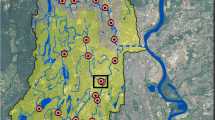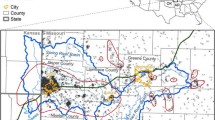Abstract
Metal releases have been received by the Grand Lake watershed from the Tri-State Mining District (TSMD) since the mid 1800s. To address data gaps in metal distributions in the Oklahoma portion of the watershed, streambed sediment and floodplain soil was sampled on various streams. The <63-µm fraction was analyzed for Cd, Pb, and Zn concentrations by portable X-ray fluorescence spectroscopy and inductively coupled plasma-mass spectrometry. Mean metal concentration results at reference transects indicated that background sediment/soil concentrations for Cd, Pb, and Zn within the watershed were 0.5, 19, and 68 mg/kg, respectively. A significant difference in the distributions of metal concentrations was found between reference and impacted transects (Cd, Pb, Zn: p = 0.00; Cd: n = 29; Pb, Zn: n = 283). These results demonstrated that concentrations of metals in streambed sediments and floodplain soils were significantly higher in areas downstream of major mining influences relative to upstream reference sites, and the source of metal contamination within these media was the result of mining releases from the TSMD. Toxicity risks to benthic macroinvertebrates were evaluated using a TSMD-specific sediment mixture model (∑PEC-QCd,Pb,Zn) for metals (MacDonald et al. in Development and evaluation of sediment and pore-water toxicity thresholds to support sediment quality assessments in the Tri-State Mining District (TSMD), Missouri, Oklahoma, and Kansas. Draft Final Technical Report. Volume I: Text. Prepared for the U.S. Environmental Protection Agency and the U.S. Fish and Wildlife Service. Prepared by MacDonald Environmental Sciences Ltd., U.S. Geological Survey, and CH2M Hill, Nanaimo, 2009). Toxicity risks to plant populations were also assessed by comparing soil metal concentrations to Ecological Soil Screening Levels (Eco-SSLs). It was found that the survival and/or biomass of benthic invertebrates was highly impacted at Tar Creek, highly to moderately impacted at Spring River and Elm Creek, and unimpacted at Lost Creek and Grand Lake as a result of sediment metal concentrations. It also was found that soil metal concentrations were likely sufficient to impact plant populations at all streams. Within the Oklahoma portion of the watershed, the majority of environmental studies, remediation, and restoration efforts by local, state, and federal agencies have been primarily focused within the Tar Creek Superfund Site (TCSS) boundary. Importantly, the findings of this study highlighted the downstream extent of metals contamination as well as the resulting potential toxicities to benthic invertebrates and plants that is present outside of the TCSS boundary. Because the Oklahoma portion of the watershed comprises the jurisdictional lands of ten tribes, these results emphasized the potential tribal loss of use of benthic invertebrates and plants due to their decline in population as a result of metal toxicity. These overall findings provide an important basis for future data needs in assessing metal concentrations in aquatic and terrestrial biota that are consumed by tribal communities within the watershed to determine if certain organisms are unsafe to consume or warrant consumption advisories. This will allow risk assessors and risk managers to better understand the potential loss of use of tribal biological resources as well as improving risk-based decision making to be protective of these resources and tribal human health.



Similar content being viewed by others
Notes
These are the Cherokee Nation, Eastern Shawnee Tribe of Oklahoma, Miami Tribe of Oklahoma, Modoc Tribe of Oklahoma, Ottawa Tribe of Oklahoma, Peoria Tribe of Indians of Oklahoma, Quapaw Tribe of Oklahoma, Seneca-Cayuga Tribe of Oklahoma, Shawnee Tribe, and Wyandotte Nation.
References
Allert AL, Wildhaber ML, Schmitt CJ, Chapman D, Callahan E (1997) Toxicity of sediments in pore-waters and their impact on Neosho Madtom, Noturus placidus, in the Spring River system affected by historic zinc-lead mining and related activities in Jasper and Newton counties, Missouri and Cherokee County, Kansas. Final Report to the U.S. Fish and Wildlife Service, Region 3. Columbia, MO
Allert AL, DiStefano RJ, Schmitt CJ, Fairchild JF, Brumbaugh WG (2012) Effects of mining-related metals on riffle-dwelling crayfish in southwestern Missouri and southeastern Kansas, USA. Arch Environ Contam Toxicol 63:563–573
Andrews WJ, Becker MF, Mashburn SL, Smith JD (2009) Selected metals in sediments and streams in the Oklahoma Part of the Tri-State Mining District, 2000–2006. U. S. Geological Survey Scientific Investigations Report 2009-5032
Angelo RT, Cringan MS, Chamberlain DL, Stahl AJ, Haslouer SG, Goodrich CA (2007) Residual effects of lead and zinc mining on freshwater mussels in the Spring River Basin (Kansas, Missouri, and Oklahoma, USA). Sci Total Environ 384:467–496
Bailey EHS (1911) Preliminary report on stream pollution by mine waters in southeastern Kansas. In: Parker HN (ed) Quality of the water supplies of Kansas: U.S. Geological Survey Water-Supply Paper 273, pp 349–361
Barks JH (1977) Effects of abandoned lead and zinc mines and tailings piles on water quality in the Joplin area, Missouri. U.S. Geological Survey Water-Resources Investigations 77–75
Dames & Moore (1995) Final Remedial Investigation Neck/Alba, Snap, Oronogo/Duenweg, Joplin, Thoms, Carl Junction, and Waco Designated Areas. Prepared for the Jasper County Respondents and the U.S. Environmental Protection Agency. Jasper County, Missouri
Ferrington LC, Galle OK, Blackwood MA, Wright CA, Schmitt FJ, Jobe JM (1989) Occurrence and biological effects of cadmium, lead, manganese, and zinc in the Short Creek/Empire Lake aquatic system in Cherokee County, Kansas. Kansas Water Resources Research Institute, contribution no. 277. U.S. Geological Survey Scientific Investigations Report G1563-06
Gibbons JD, Chakraborti S (1992) Nonparametric statistical inference, 3rd edn. Marcel Dekker, New York
Horowitz AJ (1991) A primer on sediment-trace element chemistry, 2nd edn. Lewis Publishers, Chelsea
Hotelling H, Pabst MR (1936) Rank correlation and tests of significance involving no assumption of normality. Ann Math Stat 7:29–43
Juracek KE (2006) Sedimentation and occurrence and trends of selected chemical constituents in bottom sediment, Empire Lake, Cherokee County, Kansas, 1905–2005. U.S. Geological Survey Scientific Investigations Report 2006-5307
Juracek KE, Becker MF (2009) Occurrence and trends of selected chemical constituents in bottom sediment, Grand Lake O’ the Cherokees, northeast Oklahoma, 1940–2008. U.S. Geological Survey Scientific Investigations Report 2009-5258
MacDonald DD, Ingersoll CG, Berger TA (2000) Development and evaluation of consensus-based sediment quality guidelines for freshwater ecosystems. Arch Environ Contam Toxicol 39:20–31
MacDonald DD, Smorong DE, Ingersoll CG, Besser JM, Brumbaugh WG, Kemble N, May TW, Ivey CD, Irving S, O’Hare M (2009) Development and evaluation of sediment and pore-water toxicity thresholds to support sediment quality assessments in the Tri-State Mining District (TSMD), Missouri, Oklahoma, and Kansas. Draft Final Technical Report. Volume I: Text. Prepared for the U.S. Environmental Protection Agency and the U.S. Fish and Wildlife Service. Prepared by MacDonald Environmental Sciences Ltd., U.S. Geological Survey, and CH2M Hill, Nanaimo
MacDonald DD et al (2010) Advanced screening-level ecological risk assessment (SLERA) for aquatic habitats within the Tri-State Mining District, Oklahoma, Kansas, and Missouri. Draft Final Technical Report. Nanaimo, British Columbia, MacDonald Environmental Sciences Ltd
Massey FJ (1951) The Kolmogorov–Smirnov test for goodness of fit. J Am Stat Assoc 46:68–78
McCormick CA, Burks SL (1987) Bioavailability and toxicity of extracts from acid-mine-waste-contaminated sediments. Proc Oklahoma Acad Sci 67:31–37
Pope LM (2005) Assessment of contaminated streambed sediment in the Kansas part of the historic Tri-State lead and zinc mining district. U.S. Geological Survey Scientific Investigations Report 2005-5251
Royston JP (1992) Approximating the Shapiro–Wilk W-test for non-normality. Stat Comput 2:117–119
Schmitt CJ, Wildhaber ML, Allert AL, Poulton BC (1997) The effects of historic zinc-lead mining and related activities in the Tri-State Mining District on aquatic ecosystems supporting the Neosho madtom, Noturus placidus, in Jasper County, Missouri; Ottawa County, Oklahoma; and Cherokee County, Kansas. Final Report to the U.S. Environmental Protection Agency, Region IIV. Kansas City, Kansas
Shapiro SS, Wilk MB, Chen HJ (1968) A comparative study of various tests for normality. J Am Stat Assoc 63:1343–1372
Spearman C (1904) The proof and measurement of correlation between two things. Am J Psychol 15:72–101
Spruill TB (1987) Assessment of water resources in lead-zinc mined areas in Cherokee County, Kansas, and adjacent areas. U.S. Geological Survey Water-Supply Paper 2268
Stewart D (1986) A brief description of the historical, ore production, mine pumping, and prospecting of the Tri-State Zinc-Lead District of Missouri, Kansas, and Oklahoma. In: Hagni R (ed) Guidebook to the geology and environmental concerns in the Tri-States Lead-Zinc District, Missouri, Kansas, Oklahoma. Division of Geology and Land Survey-Department of Natural Resources, Department of Geology and Geophysics, University of Missouri-Rolla, Rolla, pp 16–21
U.S. EPA (1996) Method 3050B: acid digestion of sediments, sludges, and soils. U.S. Environmental Protection Agency, Washington, DC
U.S. EPA (2005a) Ecological soil screening levels for cadmium. Office of Solid Waste and Emergency Response. U.S. Environmental Protection Agency, Washington, DC
U.S. EPA (2005b) Ecological soil screening levels for lead. Office of Solid Waste and Emergency Response. U.S. Environmental Protection Agency, Washington, DC
U.S. EPA (2007a) Ecological soil screening levels for zinc. Office of Solid Waste and Emergency Response. U.S. Environmental Protection Agency, Washington, DC
U.S. EPA (2007b) Framework for metals risk assessment. Office of the Science Advisor, Risk Assessment Forum, U.S. Environmental Protection Agency, Washington, DC
U.S. EPA (2007c) Method 6020A: Inductively Coupled Plasma-Mass Spectrometry. U.S. Environmental Protection Agency, Washington, DC
U.S. EPA (2007d) Method 6200: Field portable X-ray fluorescence spectrometry for the determination of elemental concentrations in soil and sediment. U.S. Environmental Protection Agency, Washington, DC
U.S. EPA (2008) Record of Decision Operable Unit 4 Chat Piles, Other Mine and Mill Waste, and Smelter Waste Tar Creek Superfund Site. U.S. Environmental Protection Agency, Region 6. Ottawa County, OK
Acknowledgements
The authors would like to thank the Cherokee Nation, Eastern Shawnee Tribe of Oklahoma, Miami Tribe of Oklahoma, Ottawa Tribe of Oklahoma, Seneca-Cayuga Tribe of Oklahoma, and Wyandotte Nation for funding this study. The authors also extend their sincere appreciation to Janice Wilson and Kathy Welch (Wyandotte Nation Environmental Department) for their sampling assistance, Jason White (Cherokee Nation Environmental Department) for his aid in XRF metal analysis, and Kit Garvin (Tribal Environmental Management Services) for driving the boat and sampling assistance.
Author information
Authors and Affiliations
Corresponding author
Rights and permissions
About this article
Cite this article
Garvin, E.M., Bridge, C.F. & Garvin, M.S. Screening Level Assessment of Metal Concentrations in Streambed Sediments and Floodplain Soils within the Grand Lake Watershed in Northeastern Oklahoma, USA. Arch Environ Contam Toxicol 72, 349–363 (2017). https://doi.org/10.1007/s00244-017-0376-y
Received:
Accepted:
Published:
Issue Date:
DOI: https://doi.org/10.1007/s00244-017-0376-y




